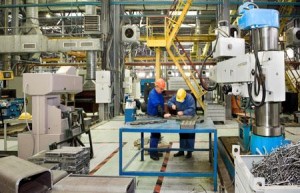 ASTANA – In the near future, the Kazakh-Czech Technology Centre (KCTC) in the capital, which was founded as a part of several investment projects, will become one of the best examples of high-tech domestic engineering.
ASTANA – In the near future, the Kazakh-Czech Technology Centre (KCTC) in the capital, which was founded as a part of several investment projects, will become one of the best examples of high-tech domestic engineering.
Today, the centre is focusing on three areas. It is a platform for cutting-edge Czech technology and equipment; it also fills specific orders from domestic enterprises and provides training for personnel on how to operate such equipment. The KCTC is also a high-tech enterprise that deals with complex parts and tools used in machine building that has a training centre for engineers, operators, IT specialists, electricians and mechanics able to work with multifunctional class A and B machines.
KCTC specialists have successfully entered the market by filling the orders of railway enterprises. In particular, they manufacture equipment for two Astana engine assembly plants. The total cost of such orders had reached 660 million tenge (US$4.2 million) by the end of 2013.
Astana is among the top three regional leaders in attracting foreign investments to new business projects. Today, this zone of investment activity involves about 1,247 companies with foreign capital. The lion’s share of the companies are from Russia with 408. Turkey boasts 167, Germany – 93, Netherlands – 47, the U.S. – 47 and China – 30.
At present, the manufacturing industry dominates capital’s industrial sector. Its share of regional industry is 80.2 percent.
The share of machinery engineering in the manufacturing sector of Astana reached 51.3 percent thanks to the State Programme of Accelerated Industrial and Innovative Development (SPAIID). This is also explained by the availability of two new factories in the industrial zone – a General Electric engine assembly plant and a railway passenger car plant belonging to Talgo. These two unique factories today are steadily picking up production and establishing themselves.
The capital’s railway and aircraft equipment industry, along with the other high tech items it produces, stimulate certain sectors of the economy and the small and medium-sized business sector. The rise of industry in Astana has made the city a place where engineers and engineering workers come together.
The country plans to build “smart” factories through harnessing the latest technology and fostering local innovation. Demonstration platforms such as the Astana Technology Centre will help solve many economic problems associated with modernising enterprises and coping with industry personnel shortages.
“Today, the Technology Centre employs 42 specialists who trained in the Czech Republic. The labour productivity per person in 2013 was about $65,000. In the future, the centre needs design and production engineers to further implement its plans,” said KCTC Director Serik Maselov.
Everyone is sure that it is necessary to get the young people who are studying overseas as part of the Bolashak programme involved in order to diversify the industrial sector of the economy with qualified engineering and technical staff whose expertise is in key sectors of the economy.


